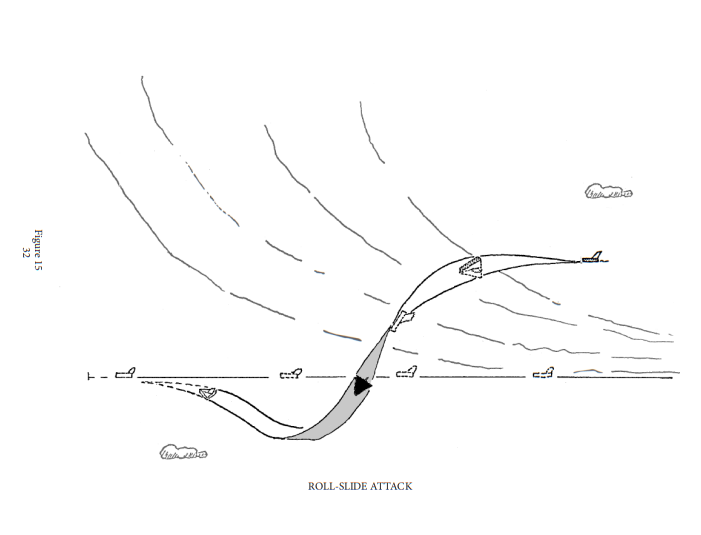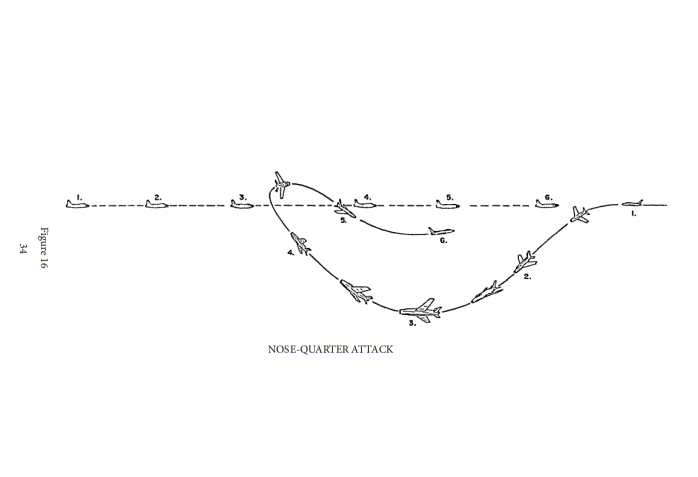Best Type of Attack Against a Non-maneuvering Target with the 20MM Cannon -- Flight Tactics
Maneuvering for the Attack
Success, in air-to-air combat, depends on the ability of a pilot to place himself in a position from which he can deliver his fire power. In fighter versus-bomber combat, time is important also and can be considered a measurement of success. To illustrate: If we have a bomber attempting to destroy a given target, we must not only position ourselves to deliver our fire power, but must also expedite our positioning before the bomber reaches “bombs away” points. Since timing is so critical, we must use the very best method by which we can position ourselves for this attack. As we have shown, the best weapon in terms of performance and ease of delivery, is AIM-9B. The best attack with this weapon and our aircraft, is the underside attack. Positioning for this attack depends upon the space relationship between you and the target. Considering this relationship, GCI may provide a set-up from three possible positions.
- Nose-quarter
- Abeam, or 90°
- Tail-quarter
Assuming VFR conditions, it will be the responsibility of each attacker – upon visually acquiring the target – to maneuver from any one of these set-ups to the firing envelope behind the target. To get into this position quickly, an attacker must maneuver in a three-dimensional field to acquire the maximum benefits from airspeed and turn. If the attacker does not understand three-dimensional maneuvering, he will be little more effective than GCI in maneuvering from a setup or approach, to a final firing position (GCI will place him in the firing envelope through the use of twodimensional maneuvers)
The Nose-Quarter Attack
In performing the nose-quarter attack, we do not choose to approach our target from a direct head-on position. If we do, we will be forced to perform a 180° change of direction by executing a level or a climbing turn (high-speed yo-yo) to approach our target from a six-o’clock position. The time consumed in a level turn allows the target to generate a great amount of longitudinal separation. This allows the target aircraft to make considerable penetration of a defense area before the attacker can set up a missile attack. The climbing turn or high-speed yo-yo allows the attacker to complete his change of direction in less time; however, at the end of this maneuver, the attacker will find himself with considerable longitudinal separation in relation to the target, since his airspeed has decayed considerably below that of the target. Once again, the target aircraft will effect considerable penetration before the attacker can position himself to launch AIM-9B. If the attacker is directed by GCI for a nose-quarter attack, he should request GCI to set him up on an anti-parallel course to an offset point 15,000 feet to one side of the target’s line of flight. When the attacker visually acquires the target, or when GCI indicates that he is ten miles from the target, the attacker should apply full afterburner power. At the same time, he should dive to an altitude about 5,000 feet below the target, so he will be offset in both the vertical and horizontal planes. This provides the attacker with maneuvering airspeed and a position from which to execute a chandelle followed by a low-speed yo-yo (a dive behind and below the target) to the attack cone behind the target. See figure 16. Compared to a level turn, this maneuver allows the attacker to complete his 180° change of direction more rapidly. In addition, since the attacker is turning through both the vertical and horizontal planes, his horizontal turning component is reduced. As a result of these two factors – fast turn rate and small turn radius – the attacker will be in a position much nearer the target’s attack cone. To prevent the target from penetrating the defense area excessively, the attacker must dive behind and below the target at the completion of 90° of turn. This will aid the attacker in recouping the speed lost in the chandelle. Also, it allows him to turn inside the target’s line of flight, because he is able to reduce his horizontal turning component by maneuvering through both the vertical and horizontal planes. Result: The attacker quickly positions himself – at six-o’clock-low – to launch Sidewinder.
The Beam or 90° Approach
In a beam approach, our problem remains essentially the same as that in a nose-quarter attack. That is, we must quickly place the attacker in a launch position, to reduce penetration time. The best means by which to accomplish this, upon visually acquiring the target, is to use afterburner and perform a diving turn, below and behind the target’s line of flight. Once again, afterburner, coupled with a descending turn, will increase rate of closure, because of rapid acceleration. At the same time, since the turn is through both the vertical and horizontal planes, a cutoff is easily effected. Result: the attacker is quickly set up for a missile attack from six-o’clock-low. If the beam attack starts from a high position, the same procedures should still be used. Remember, the attacker wants to reduce the target’s penetration time. At the same time, he wants to set up for the best possible attack. A diving turn or low-speed yo-yo will satisfy both of these conditions. If a beam attack is initiated from a low position, the previous procedures still apply, since the attacker is trying to reduce target penetration time by rapid closure and a cutoff inside the target’s line of flight.
Tail-quarter attack
In a tail-quarter attack, the problem of defense area penetration is most critical. To reduce this penetration time and to allow the attacker to position himself for the best possible missile attack, he must accomplish a dive below and inside his opponent’s line of flight, up to an attack position (inside yo-yo). Since penetration time is so critical, the procedure will remain the same whether the attack starts from a high or low position.
Best Type of Attack Against a Non-maneuvering Target with the 20MM Cannon -- Flight Tactics

